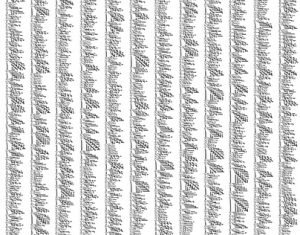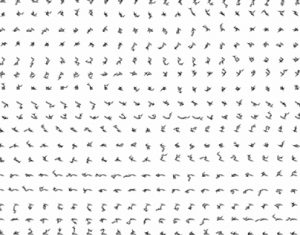This week I will be discussing art created by Rami Hammour, and alum of the Rhode Island School of Design. His work deals in generation and randomness, not without limitations though. Each art piece has a different set of parameters so I’ll discuss two examples.

“A Text of Random Meaning”
“This text-like visualization is a mapping of a “Register and Taps” random number generator in action. The drawing comparing three registers: 9, 11 and 13. It shows the difference in values, and counting of the generated numbers while highlighting the taps.” -Rammi Hammour
The limits of this piece are in the three different registers and the visual part of the piece is able to have some sense of flow and form because of it.

“Exhaustive Permutation and Bubble Sort”
“A 30-60-90 Triangle could meets with another identical triangle in defined 7 different ways. If no repetition occurred this will yield an exhaustive 5040 assembly. 8 triangles are needed to exhaustively have all 7 cases in each assembly, also conditional to no repetition occurring.”
Studying the purpose of ‘randomness’ in computational art is that really, it’s hard to get completely random results, as otherwise a piece might be limitless. In order to make the piece function and flow some limitation must be present. Even in the example from class with the “limitless” moving squares. They were limited by the canvas, by color, and by size though labeled random.
![[OLD FALL 2018] 15-104 • Introduction to Computing for Creative Practice](wp-content/uploads/2020/08/stop-banner.png)